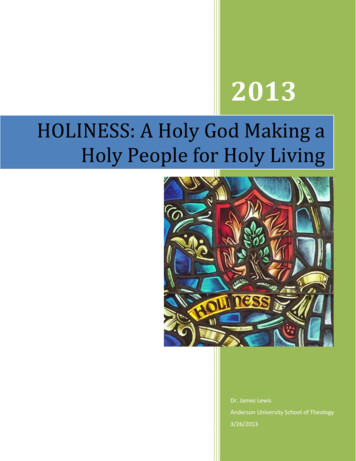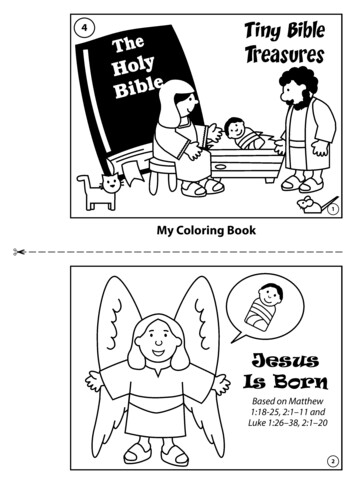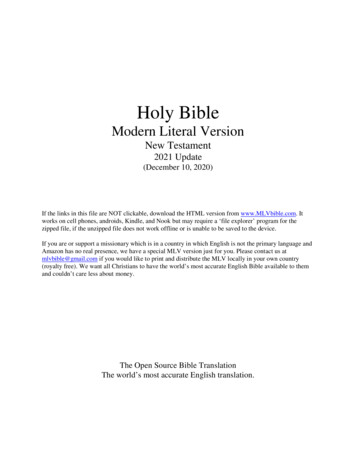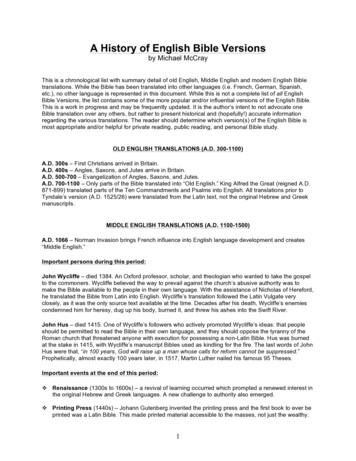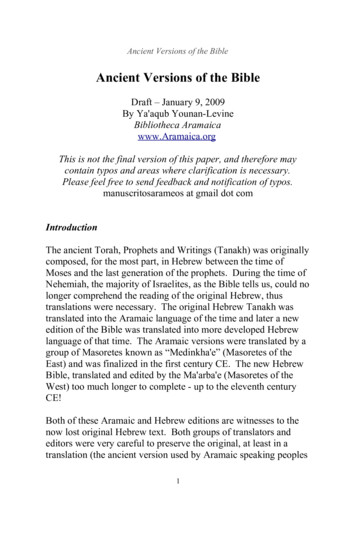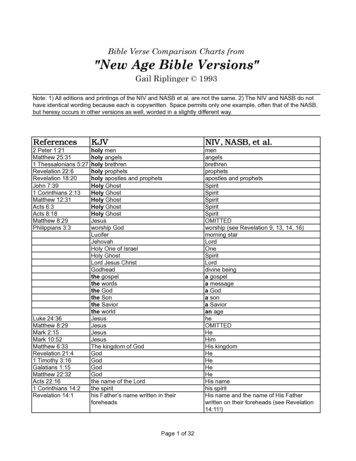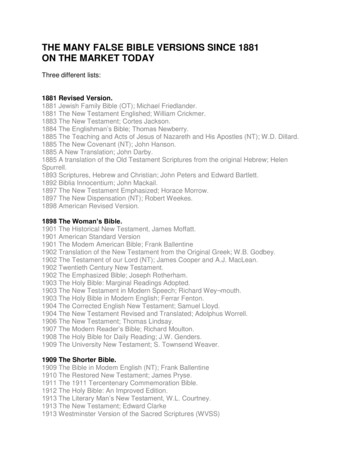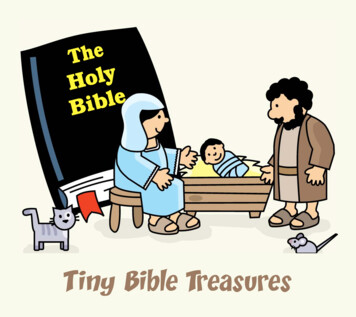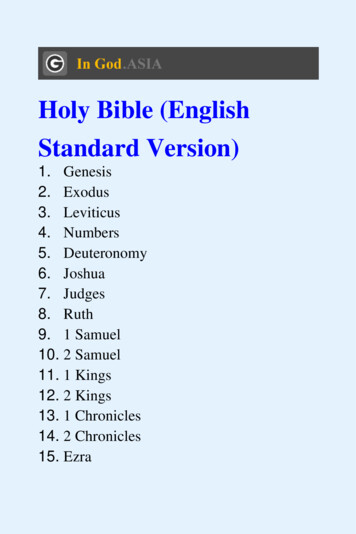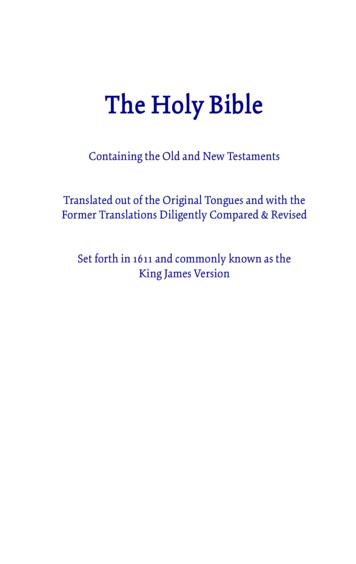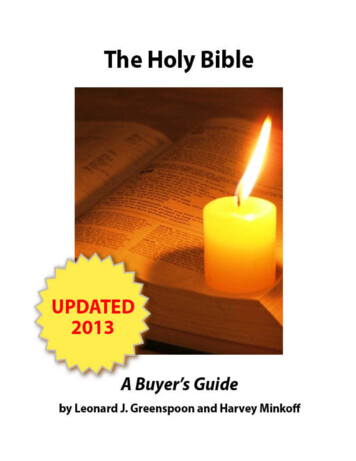
Transcription
The Holy Bible: A Buyer’s Guide 2013 Biblical Archaeology Societyi
The Holy Bible: A Buyer’s GuideThe Holy Bible: A Buyer’s GuideStaff for this book:Sara Murphy, Megan Sauter and Noah Wiener – EditorsRobert Bronder – DesignerSusan Laden – Publisher 2013Biblical Archaeology Society4710 41st Street, NWWashington, DC 20016www.biblicalarchaeology.org 2013 Biblical Archaeology Societyi
The Holy Bible: A Buyer’s GuideAbout the Biblical Archaeology SocietyThe excitement of archaeology and thelatest in Bible scholarship since 1974The Biblical Archaeology Society (BAS) was founded in 1974 as a nonprofit,nondenominational, educational organization dedicated to the dissemination of information aboutarchaeology in the Bible lands.BAS educates the public about archaeology and the Bible through its bi-monthlymagazine, Biblical Archaeology Review, an award-winning web site www.biblicalarchaeology.org,books and multimedia products (DVDs, CD-ROMs and videos), tours and seminars. Our readersrely on us to present the latest that scholarship has to offer in a fair and accessible manner. BASserves as an important authority and as an invaluable source of reliable information.Publishing ExcellenceBAS’s flagship publication is Biblical Archaeology Review. BAR is the only magazine thatconnects the academic study of archaeology to a broad general audience eager to understandthe world of the Bible. Covering both the Old and New Testaments, BAR presents the latestdiscoveries and controversies in archaeology with breathtaking photography and informativemaps and diagrams. BAR’s writers are the top scholars, the leading researchers, the worldrenowned experts. BAR is the only nonsectarian forum for the discussion of Biblical archaeology.BAS produced two other publications, Bible Review from 1985–2005, and ArchaeologyOdyssey from 1998–2006. The complete editorial contents of all three magazines are availableon the BAS Library. The BAS Library also contains the text of five highly-acclaimed books,Ancient Israel, Aspects of Monotheism, Feminist Approaches to the Bible, The Rise of AncientIsrael and The Search for Jesus. Yearly memberships to the BAS Library are available toeveryone at www.biblicalarchaeology.org/library. This comprehensive collection of materials isalso available to colleges, universities, churches and other institutions at www.basarchive.org.Widespread AcclaimThe society, its magazine, and its founder and editor Hershel Shanks have been thesubject of widespread acclaim and media attention in publications as diverse as Time, People,Civilization, U.S. News and World Report, The New York Times, The Washington Post and TheJerusalem Post. BAS has also been featured on television programs aired by CNN, PBS and theDiscovery Channel. To learn more about the Biblical Archaeology Society and subscribe to BAR,go to www.biblicalarchaeology.org. 2013 Biblical Archaeology Societyii
The Holy Bible: A Buyer’s GuideFurther Reading in the BAS Librarywww.biblicalarchaeology.org/libraryOver the years, the Biblical Archaeology Society has printed millions of words on topicsfrom Jesus to Jerusalem, from the Dead Sea Scrolls to scientists' fear of the approaching deathof the Dead Sea itself. Each of the over 6000 we have published in the past 35 years is fullyavailable and fully searchable in the online BAS Library. Every photograph, more than 18,500 ofthem, is also fully viewable--along with the captions, of course.Whether it's to research a paper, to prepare a sermon, to deepen your understanding ofscripture or history, or simply to marvel at the complexity of the Bible, the most important book inhistory, the BAS Library is an invaluable tool that cannot be matched anywhere else. Find outmore at www.biblicalarchaeology.org/library.Bailey, Lloyd R. “What a Concordance Can Do for You,” BAR 10:06.Beegle, Dewey M. “What Does the Bible Say?” BAR 08:06.Cross, Frank M. “New Directions in Dead Sea Scroll Research I: The Text Behind the Text of theHebrew Bible,” BR 01:02.Epp, Eldon. “Should ‘The Book’ Be Panned?” BR 02:02.Fleming, James. “Putting the Bible on the Map,” BAR 09:06.Greenspoon, Leonard J. “Mission to Alexandria: Truth and Legend About the Creation of theSeptuagint, the First Bible Translation,” BR 05:04.Harrelson, Walter, “What Is a Good Bible Dictionary?” BAR 12:06.LaSor, William Sanford. “Learning Biblical Languages,” BAR 13:06.Minkoff, Harvey. “Problems of Translations,” BR 04:04.Additional Further ReadingBailey, Lloyd R, ed. The Word of God: A Guide to English Versions of the Bible. Atlanta: JohnKnox, 1982.Comfort, Philip W. The Complete Guide to Bible Versions. Wheaton, IL: Tyndale House, 1991.Kubo, Sakae and Walter F. Specht. So Many Versions? Grand Rapids, MI: Zondervan, 1983. 2013 Biblical Archaeology Societyiii
The Holy Bible: A Buyer’s GuideTable of Contents 2013 Biblical Archaeology Societyiv
The Holy Bible: A Buyer’s GuideIntroductionAre you looking to buy a Bible? If you’re anything like me, the first place you would look ison Amazon.com. That’s the easiest and fastest way for me to learn what’s available, and abouthow much I can expect to spend.But if you search for “Holy Bible” in Amazon’s Books section, you are faced with 75,996results—dozens of different translations and versions, hundreds of editions and countlessvarieties of packaging designed for every conceivable audience in a seemingly endless list ofentries.Unless you know in advance which exact translation and edition is the one for you, theamount of choice is dizzying. The Holy Bible: A Buyer’s Guide is designed to help you sortthrough Bible translations and editions, and to help you make the important choice about whichBible to purchase. Written by prominent Biblical scholars Leonard J. Greenspoon and HarveyMinkoff, this free e-book will guide you through 27 different Bible versions and address theircontent, text, style and religious orientation.New Bible editions and translations are published every year, and this newly updatededition features discussions by Leonard Greenspoon on six new Bible versions published through2013, including excerpts from the Bibles’ introductions, the opening verses in Genesis andGreenspoon’s remarks on the translation, style and theology of each edition.This newly updated free e-book will serve as a valuable guide to choosing the Bible thatis right for you.Sara MurphyWebmaster, Biblical Archaeology Society2010Updated by Noah WienerWeb Editor, Biblical Archaeology Society2013 2013 Biblical Archaeology Societyv
The Holy Bible: A Buyer’s GuideThe Holy Bible: A Buyer’s GuideBy Leonard J. GreenspoonWalk through the religion section of any major bookstore, and you’ll see an amazingarray of Bibles. The broad selection of translations (also called versions)—and the seeminglyendless ways in which they are packaged—is without historical precedent. But for many people, itis also bewildering, if not frustrating. Rather than the “blessing” it could and probably should be, itmay be off-putting. When faced with a host of adjectives like “new” and “revised,” thoughtfulbuyers might well ask, What was wrong with the “old” or “traditional” or, dare I say it, the“original”?And it doesn’t stop there. How can a buyer tell when a Bible is a different translation (orversion) or the same old text in a new coat? Some publishers put out several translations. Oxford,for example, prints copies of the New Revised Standard Version, the Jewish Publication SocietyTanakh, the New American Bible, the New King James Version, the old King James Version andmore. And several publishers put out the same translations: Eight different publishers have beengiven broad licenses to publish the New Revised Standard Version, for example. And sometimespublishers put out one translation under numerous different titles. Zondervan’s Devotional Biblefor Dad, Revolution: The Bible for Teen Guys, and True Images: The Bible for Teen Girls all 2013 Biblical Archaeology Society1
The Holy Bible: A Buyer’s Guidecontain the same translation (the New International Version—the most popular translation today)with distinctive covers on the outside and different annotations, devotional aids and interpretivematerials on the inside.Some Bibles are aimed at specific religious groups, but this is not always clear from thetitle. How is a Bible buyer to know that the New American Bible is prepared by and for RomanCatholics, while the similarly named New American Standard Bible is aimed at conservativeProtestants?On the following pages, I try to answer such questions in as straightforward, objectiveand succinct a manner as I can. With this goal in mind, I have chosen 21 versions or families ofversions. After providing some basic publication data for the edition I used, I offer a quotationfrom each version’s own introduction that highlights its distinctive features or accomplishments. Ithen cite the same verses, Genesis 1:1–2, for each version and offer my own comments.My Bible guide is far from the first such effort, nor will it be the last. I hope to distinguishmy analysis from others by allowing each version to speak on its own behalf.I have grouped the translations in three broad categories: literal; nonliteral with extendedvocabulary; and nonliteral with limited vocabulary or colloquial language. The literal versionscome closest to providing a word-for-word translation in terms of the grammar, vocabulary andstyle of the original; nonliteral versions with extended vocabulary attempt to provide a Bible thatremains close to the original but makes use of more up-to-date vocabulary and style; the othernonliteral versions restrict the scope of their vocabulary and the complexity of their grammar.Each of these approaches has its own appeal and drawbacks; for example, a literal versionbrings modern readers closest to the ancient text, but often at the expense of intelligibility; theless literal a version is the easier it is for today’s readers to comprehend, but readers can easilylose the feeling that they are dealing with an ancient text.Not every reader will agree with my approach. Rest assured, I am under no illusions: Mywords, unlike Sacred Writ, are not inscribed in stone. In this admission I am in excellent company:The translators of the King James Version made much the same point in their introduction! 2013 Biblical Archaeology Society2
The Holy Bible: A Buyer’s GuideNew Edition of The Buyer’s Guide—Revised 2013At the request of the editors of BAR, I have expanded my “Buyer’s Guide” through theaddition of six new English-language versions of the Bible, most of which had not been published(or fully published) when the “Guide” first appeared in Fall 2005. I am grateful for this opportunity,especially since the production of new versions has continued unabated since that time.At least one of these new versions falls into each of the categories I set up earlier: LiteralTranslations, Non-Literal Translations (with Extended Vocabulary) and Non-Literal Translations(with Limited Language). At the same time, these new editions do exhibit some features not seenin earlier translations, especially those that allow for enhanced internet availability in addition totraditional print copies.I have tried to fashion the new entries so that they fit in seamlessly with the earlier format.After giving basic publication information about each version, I provide extended quotations fromthe introductions (or other prefatory materials) themselves. In this way I allow each translator orgroup of translators to express in their own words what they understand to be the distinctive ordefining characteristics—stylistically, theologically and in terms of paratextual information (varioustypes of footnotes, appendices, maps and other graphics, etc.)—of their version.I then present the first two verses of the first chapter of the first book of the Hebrew Bible(that is, Genesis 1:1-2) in the words of each version. There follow my own observations abouteach translation. To a large extent, I am guided by the translators themselves; that is, my primaryfocus is on how well the translators carry out the goals they themselves have set. At the sametime, I do have views of my own, which I readily offer without (I hope) clouding the reader’s visionof an assessment of each version on its own terms. This is not always an easy task, but it is onethat I think is important.I have reason to think that I have achieved a satisfactory balance. This feeling comesfrom the largely positive response that the “The Buyer’s Guide” has garnered among individualsfrom different faith communities as well as from those who do not identity with any community. Ilook forward to continued interaction with interested individuals. For me, such conversations arethe best way to gain an understanding of how the Word can most effectively be delivered to theworld we all inhabit. 2013 Biblical Archaeology Society3
The Holy Bible: A Buyer’s GuideLiteral TranslationsThe NET Bible (NET Bible)Edition: The NET Bible. New EnglishTranslation Biblical Studies Press. 2005.The cover spine includes this wording: “with60,932 translators’ notes.”Click here to purchaseIntroduction: “There is an average of two translators’ notes for each Biblical verse. The notesalone are the cumulative result of hundreds of thousands of hours of Biblical and linguisticresearch. The translator’s notes, most of which were created at the same time as the initial draftsof the translation itself, enable the reader of the NET Bible to ‘look over the shoulders’ of thetranslators as they worked.The NET Bible is a completely new translation. The project began on a rainy night in November1995 in Philadelphia, Pennsylvania at the annual meeting of the Society of Biblical Literature.The name that was chosen reflects our goals to provide the Bible to the internet audience inelectronic form in addition to the more traditional printed media.Faithfulness to the Hebrew, Aramaic and Greek in which
edition features discussions by Leonard Greenspoon on six new Bible versions published through 2013, including excerpts from the Bibles’ introductions, the opening verses in Genesis and Greenspoon’s remarks on the translation, style and theology of each edition. This newly updated free e-book will serve as a valuable guide to choosing the Bible that is right for you. Sara Murphy Webmaster,
